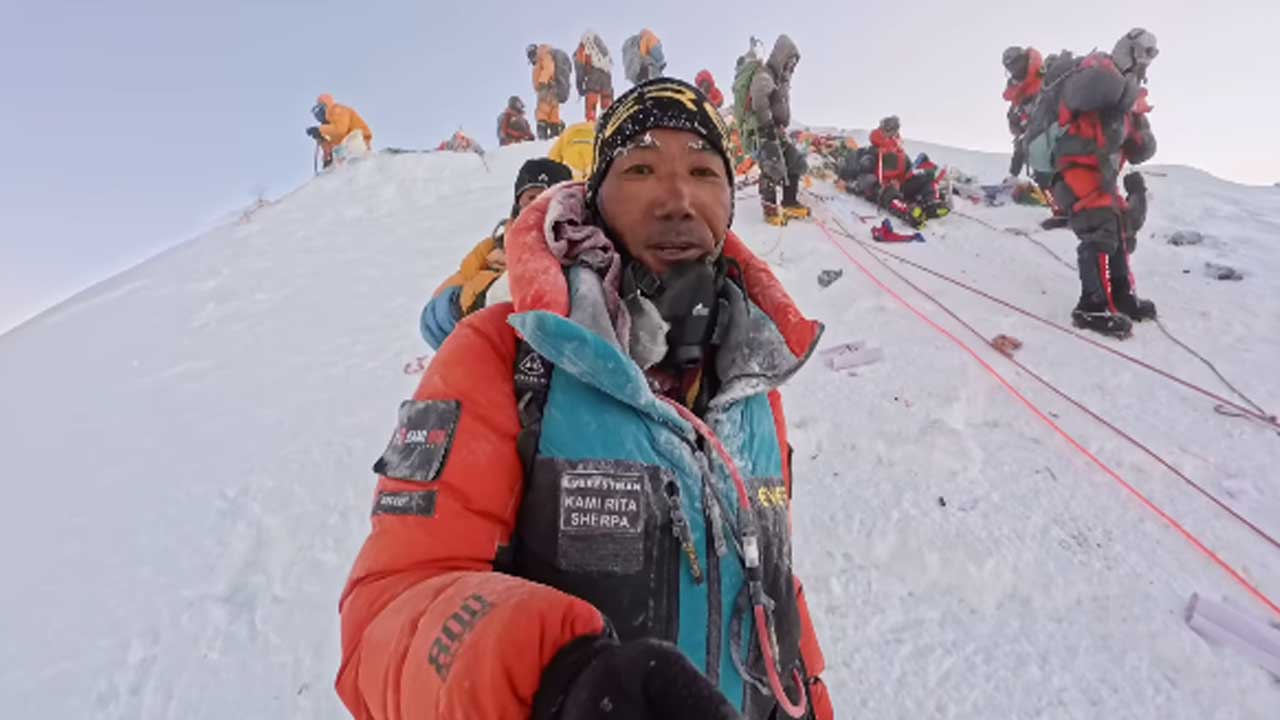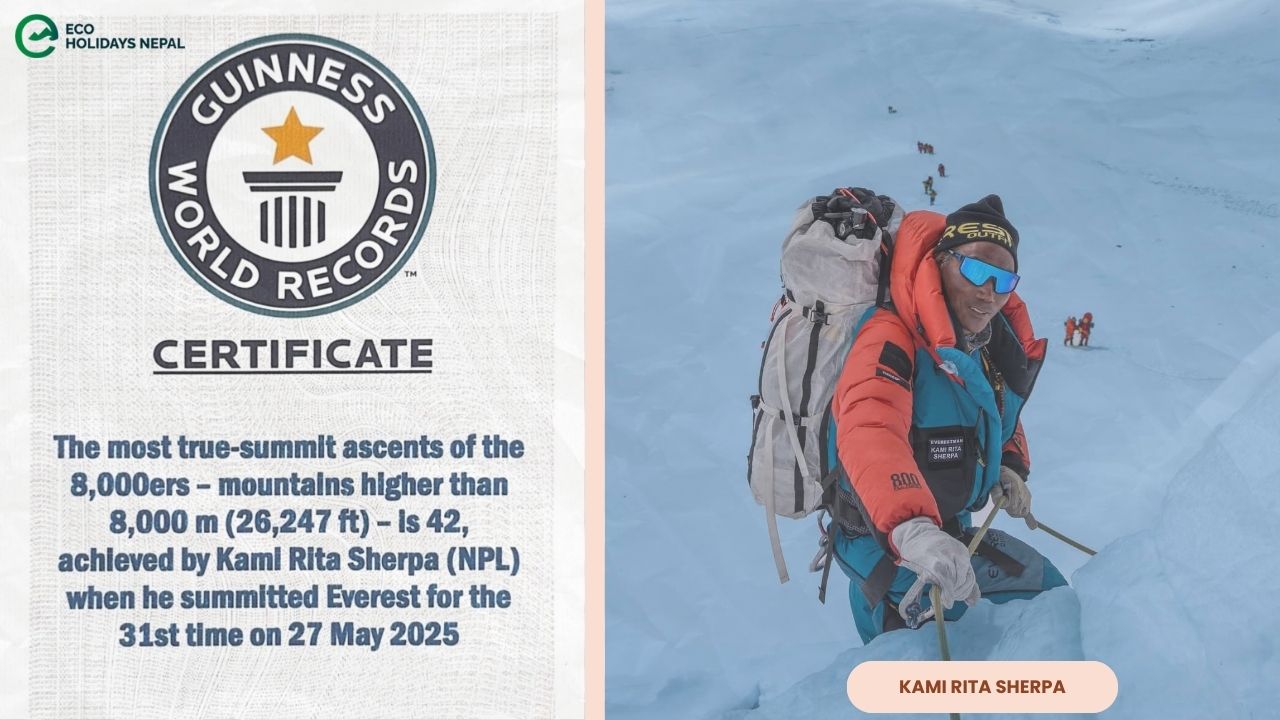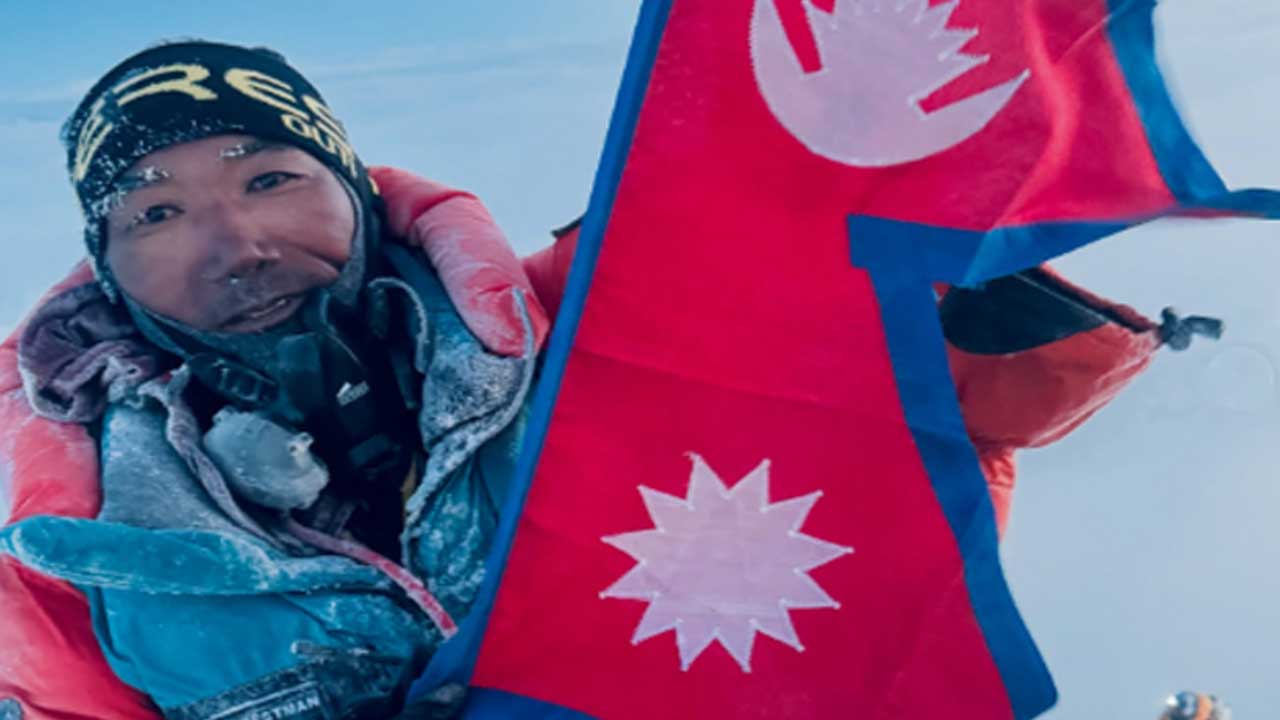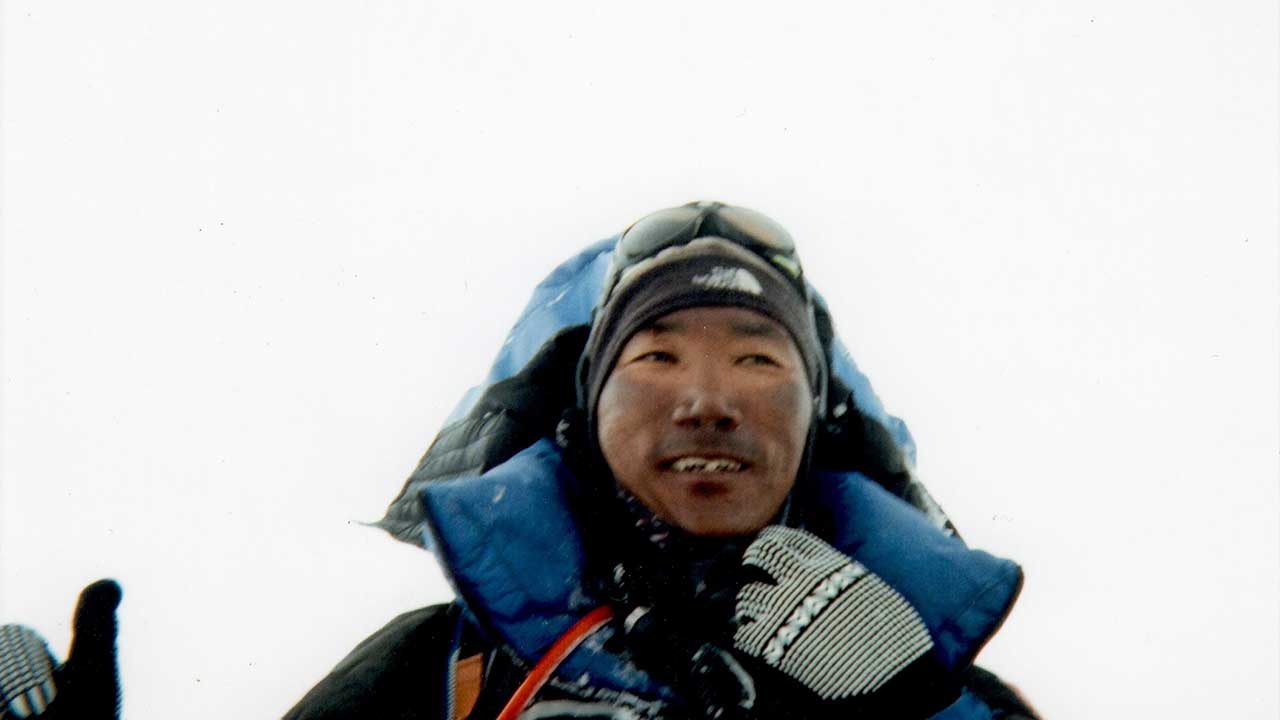“55-year-old Kami Rita Sherpa broke his own record and conquered the summit of Mount Everest 31 times– a remarkable feat more than any human in history and made a new guinness world record”
Mount Everest known as ‘Sagarmatha’ in Nepal and ‘Chomolungma’ rises at an elevation of 8,848 meters (29,031 feet) from the sea level. This colossal symbol of human aspiration and the ultimate prize in the mountaineering world has captivated adventures from all around the world for over a century.
During the peak climbing seasons; spring (March to May) and autumn (September to November), climbers from around the globe converge on Nepal to look for that perfect climbing window. For many, a single summit represents the pinnacle of personal achievement.
For others, it is a lifelong dream. But, for Kami Rita Sherpa, Mount Everest is a workplace and legacy. It is the grandest among all other peaks which he has scaled more times than any other human in recorded history.
On 27th May 2025 Kami Rita Sherpa recorded his 31st successful Everest summit breaking his previous record. His accomplishment has further extended a world record that has come to define the modern era of high-altitude mountaineering.
Before that, the legendary Sherpa Kami Rita climbed Mount Everest twice in the span of two weeks in 2024. He reached the summit of the tallest peak in the world on 12th May and 22nd May in 2024 making history with his 29th and 30th summit records.
In the mountaineering world where many climbers consider even a single summit of Mount Everest a lifetime achievement, Kami Rita’s accomplishment redefines what is humanly possible.
Who is Kami Rita Sherpa?
Early Life and Background
Kami Rita Sherpa was born on 17th January 1970 in Thame, Solukhumbu, Nepal. This high-altitude village in the northeastern part of the country rises 3,800 meters (12,467 feet) high from the sea level. This rugged Sherpa settlement has produced some of the world’s most accomplished mountaineers, including the legendary Tenzing Norgay Sherpa.
Tenzing along with Edmund Hillary scaled the summit of Mount Everest successfully for the first time on the 29th May 1953. These legendary climbing duo stood on top of the world’s highest peak after a brutal climb through a freezing climate and oxygen-thin atmosphere.
Sherpa Kami Rita grew up in such a village where one of the most famous and honored mountaineers who accomplished one of the greatest milestones in the history of mountaineering was raised. Raised in a modest household, Kami Rita grew up surrounded by mountains and mountaineers.
His father was also a mountaineering guide who led the Western expeditions after Mount Everest was opened for foreign mountaineers in 1950. Following the footsteps of his father. Kami Rita was exposed to the high-altitude life at an early age.
At a time when education was a luxury and opportunity was scarce, working on the mountains became a generational profession. A profession that was marked by physical danger, minimal recognition and deep cultural pride.

From Porter to Climbing Legend
Sherpa Kami Rita started his mountaineering career in 1992. He started helping base camp cook during the early years. Then, he slowly changed the trajectory of his career and started working as a porter. After gradually building his portfolio, he debuted in the mountaineering world.
Then, he conquered the summit of Everest for the first time in 1994 at the age of 24. Kami Rita was working as part of a commercial expedition team during his first scaling. After that, over the next three decades, he methodically built his record.
The living mountain legend kept leading and guiding climbers to the summit of Everest. He also handled dangerous technical tasks, fixing ropes, carrying oxygen cylinders and ensuring route and climber safety.
If you are not familiar with the mountaineering world, Sherpa climbers like Kami Rita bear the physical and logistical burden of the Everest climbing season. His continuous journey to the top of the world exemplifies that reality.
However, what truly sets him apart is not the repetition but the consistency, humility and impeccable leadership under extreme pressure. Besides Mount Everest, Sherpa Kami Rita has also scaled Cho Oyu, Lhotse, K2 and Manaslu, although the pinnacle point among all snow-clad peaks remains his primary domain.
Kami Rita Sherpa’s Everest Record
Kami Rita Sherpa record is not just historic, but it is unprecedented in the history of mountaineering. As of 27th May 2025, Kami Rita reached the summit of Mount Everest 31 times holding the all-time record for the most summits of the tallest peak in the world by an individual.
His climbing record spans over three decades starting in 1994. Kami Rita has remained consistent with his climbing career until 2025, often summiting twice within the same season as his 2024 record in May (spring).
This living mountaineering legend has accomplished rare and grueling feats that many mountaineers can’t imagine. Most of Kami Rita Sherpa record were made while working as a high-altitude guide and rope-fixing team leader.
Kami Rita worked for Alpine Ascents International before joining the Seven Summit Treks which is Nepal’s largest commercial expedition operator. He is also a Brand Ambassador and Chief Adventure Consultant for Himalayan Glacier Adventure and Travel Company.
Kami Rita Sherpa Record Climbs by Decade:
| Year | Number of Summits | Notable Achievements |
| 1994 to 2004 | 8 | First Everest summit in 1994; established himself as a reliable high-altitude support climber |
| 2005 to 2014 | 11 | Climbed Mount Everest nearly every year; became senior guide and rope-fixing team leader |
| 2015 to Present | 12 | Broke and set world records multiple times reached his 31st summit on 27th May 2025 |
Who Has Climbed Everest the Most?
When it comes to Everest summits, many Sherpa climbers have stood out. However, none of them have matched the consistency, longevity and sheer volume of Kami Rita Sherpa record. Standing atop the highest natural structure on the planet is a remarkable feat.
Sherpa Kami Rita who has conquered it 31 times is in a class of his own, far above even the most elite climbers. While many climbers have braved the harsh slopes of Everest, only a handful have returned again and again.
And, virtually all of them are Sherpas. They are the ethnic native group of Nepal’s high-altitude Himalayas who are known for their unmatched ability to perform at extreme altitudes.
Mount Everest Summiters by Frequency- Who Has Climbed Everest the Most?

| Number of Summits | Climber’s Name | Nationality |
| 31 | Kami Rita Sherpa | Nepal |
| 29 | Pasang Dawa Sherpa | Nepal |
| 24 | Ngima Nuru Sherpa | Nepal |
| 24 | Ange Dorje Sherpa | Nepal |
| 22 | Dorje Gyalgen Sherpa | Nepal |
| 21 | Apa Sherpa | Nepal |
| 21 | Phurba Tashi Sherpa | Nepal |
How Long Does It Take to Climb the Mount Everest?
Climbing Mount Everest is not a sprint to the top. It is a meticulously orchestrated expedition that lasts about two months. This climbing period tets human endurance, physiology, logistics and patience. Unlike the traditional alpine ascent, an Everest expedition is more akin to the campaign strategy.
The scaling heavily relies on acclimatization to reduce the risk of AMS and the weather elements. There are several phases for the expedition, here is a detailed breakdown of how long does it take to climb the Mount Everest:
Phase 1: Arrival and Trekking Period to Everest Base Camp (8 to 10 days)
Phase 2: Acclimatization Period and Rotation Climbs (Week 2 to Week 4)
Phase 3: Summit Push Period (Week 5 to Week 6)
Phase 4: Return to Base Camp and Journey Back to Kathmandu (8 to 10 days)

Why Sherpas Dominate Everest Summits?
The Himalayan Sherpas are not just mountain guides, they are the backbones of the Everest expeditions. Their unmatched summit records are not just coincidental. But, they stem from genetics, cultural, environmental and historical factors which position them as the most crucial and indispensable figures in the mountaineering world.
- The Himalayan Sherpas have gone through genetic adaptation which allows them to function more efficiently even in low-oxygen environments.
- As most Sherpas grow up in high-altitude villages from childhood their bodies develop larger lung capacity, greater aerobic endurance and natural acclimatization.
- For Sherpas, climbing is not just work but its tradition. Families pass down the mountain knowledge, weather instincts, routes and spiritual rituals tied to the mountains to the younger generations.
- Sherpas dominate the Everest summit numbers because they back up the climbers. These superhumans set the route on the mountain, carry heavy loads, guide and guide and assist clients, sometimes multiple times in a climbing season.
- They bear the greatest risk on Everest. They are the first to enter the dangerous zone and the last to leave.
Kami Rita Sherpa Personal Life
Behind the world record and glory of Sherpa Kami Rita lies a story of a humble man shaped by hardship, faith and unwavering commitment to his roots. Kami Rita was born in 1970 in Thame, a remote village in the Solukhumbu district of Nepal.
Like many Sherpa villages in the high-altitude regions, he grew up in a modest household where the economy often depended on mountaineering and trekking. His father was one of the early professional Sherpa guides after Everest was opened to foreign climbers in 1950.
Sherpa Kami Rita followed his father’s footsteps, first working as kitchen staff, then porter and finally rising through the ranks of Nepal’s climbing elites. Kami Rita is married to Lakpa Jangmu and the pair have two kids together; one daughter and a son, Lhakpa Sherpa.
Kami Rita Sherpa wife has often expressed her desire for him to retire from mountaineering seeing the dangers in the profession. Over the years she urged him to explore alternative employment options or start a small business. But, the living legend is still testing his limit of the icy slope of the mountains.

The Future: Will He Climb Again?
With 31 Everest summits under his belt at the age of 55 the obvious question looms: will Kami Rita Sherpa climb Everest again? As of 2025 Kami Rita remains physically fit and active in the mountaineering world.
He did a double summit push on 12th May and 22nd May 2024 proving that his body still can endure the extreme stress of high-altitude climbs. In an interview in 2024, Kami Rita Sherpa hinted that he would be back again and continue pushing the summit for at least two more years.
In the interview, he also stated that after retiring from guiding he would still continue working on the mountain. Not as an expedition team leader, but as a manager at the base camp. Many believe that Kami Ria may soon transition into a senior leadership or advisory role.
With his grounded nature it is not hard to see him mentoring younger Sherpas, managing expedition logistics, or helping to shape the policy for climber safety and Sherpa welfare.
Sherpa Kami Rita is seen as a symbol of resilience and he could play a public advocacy role in improving Sherpa conditions, training standards and international recognition.
Climbing Everest may not be your ideal dream. But standing at its feet, breathing the same air as legends? Well., that is within reach. Discover your own Everest at the base camp with Eco Holidays Nepal’s Everest Base Camp Trek or Everest Base Camp Trek with Helicopter Return.


